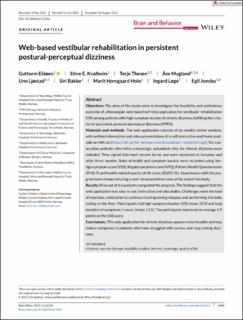| dc.contributor.author | Eldøen, Guttorm | |
| dc.contributor.author | Kvalheim, Stine E. | |
| dc.contributor.author | Thesen, Terje | |
| dc.contributor.author | Mygland, Åse | |
| dc.contributor.author | Ljøstad, Unn | |
| dc.contributor.author | Bakke, Siri | |
| dc.contributor.author | Holo, Marit Horsgaard | |
| dc.contributor.author | Løge, Ingard | |
| dc.contributor.author | Jonsbu, Egil | |
| dc.date.accessioned | 2021-11-24T13:11:18Z | |
| dc.date.available | 2021-11-24T13:11:18Z | |
| dc.date.created | 2021-09-14T20:54:46Z | |
| dc.date.issued | 2021 | |
| dc.identifier.citation | Brain and Behavior. 2021, 1-6. | en_US |
| dc.identifier.issn | 2162-3279 | |
| dc.identifier.uri | https://hdl.handle.net/11250/2831310 | |
| dc.description.abstract | Objectives
The aims of the study were to investigate the feasibility and preliminary outcome of a Norwegian web-based self-help application for vestibular rehabilitation (VR) among patients with high symptom burden of chronic dizziness fulfilling the criteria for persistent postural-perceptual dizziness (PPPD).
Materials and methods
The web application consists of six weekly online sessions, with written information and video presentations. It is self-instructive and freely available on NHI.no (https://nhi.no/for-helsepersonell/vestibular-rehabilitering/). Ten consecutive patients referred to a neurologic outpatient clinic for chronic dizziness were included. They signed informed consent forms and were examined at inclusion and after three months. State of health and symptom burden were recorded using Vertigo symptom score (VSS), Niigata symptom score (NPQ), Patient Health Questionnaire (PHQ-9) and health-related quality of life score (EQ5D-5L). Experiences with the program were measured using a semi-structured interview at the end of the study.
Results
Nine out of ten patients completed the program. The findings suggest that the web application was easy to use, instructive and educatable. Challenges were the load of exercises, motivation to continue training during relapses and performing the body rolling on the floor. Participants had high symptom burden (VSS mean 32.9) and long duration of symptoms in years (mean 11.5). The participants improved on average 6.9 points on the VSS score.
Conclusions
This web application for chronic dizziness appears to be feasible and may reduce symptoms in patients who have struggled with serious and long-lasting dizziness. | en_US |
| dc.language.iso | eng | en_US |
| dc.publisher | Wiley | en_US |
| dc.rights | Navngivelse 4.0 Internasjonal | * |
| dc.rights.uri | http://creativecommons.org/licenses/by/4.0/deed.no | * |
| dc.title | Web-based vestibular rehabilitation in persistent postural-perceptual dizziness | en_US |
| dc.type | Peer reviewed | en_US |
| dc.type | Journal article | en_US |
| dc.description.version | publishedVersion | en_US |
| dc.source.pagenumber | 1-6 | en_US |
| dc.source.journal | Brain and Behavior | en_US |
| dc.identifier.doi | 10.1002/brb3.2346 | |
| dc.identifier.cristin | 1934339 | |
| cristin.ispublished | true | |
| cristin.fulltext | original | |
| cristin.qualitycode | 1 | |

